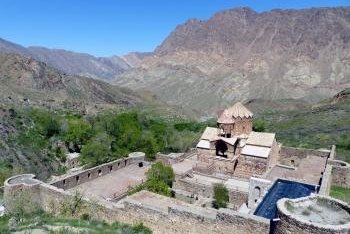
As Els has recently reviewed the St Thaddeus Church part of this WHS, I will concentrate on its second “ensemble” (the word used by UNESCO) - around St Stepanos Monastery. This lies around 15kms west of the town of Jolfa, which is itself c230kms (a 2.5 hour drive by car) north of Tabriz on the Iran-Azerbaijan frontier opposite its Azerbaijani counterpart of Julfa which is situated within the exclave of the Nakchivan Autonomous Republic.
In order to place St Stepanos in its geographic and historical context, it is perhaps worth dwelling a little on the history of nearby Julfa/Jolfa in relation to Armenia. Julfa developed in the late middle ages into a prosperous, entirely Armenian, town and was captured from the Ottomans in 1603 by Shah Abbas. He decided he couldn’t hold it and decided forcibly to evacuate its inhabitants to use their skills in helping to build/populate Isfahan! Today there is a prosperous suburb of Isfahan called “New Jolfa" which contains the highly ornamented (and recommended) Vank cathedral built by those resettled Armenians from 1606. The remains of Old Julfa became an archaeological site which included a cemetery containing many fine Khachkars. (Armenian carved tomb stones) – none of which now remain. Azerbaijan says that there never were any and Armenia that Azerbaijan destroyed them all between 1998 -2006! “Facts” would seem to support Armenia in this particular aspect of the Armenian-Azeri spat.
The road from Jolfa to St Stepanos and on to St Thaddeus runs alongside the Iran-Azerbaijan frontier and passes the location of Old Jolfa. The route has a significant military presence. This, together with the occasional military check, requires that any cameras are kept out of sight - which also prevented any photography of the Darrasham Chapel element which is situated after St Stepanos but to the right of the road almost on the river bank and very close to the frontier –it almost seemed to be a part of the military check post! (In fact the core areas of both St Stepanos AND of Darrasham Chapel actually reach to the Araxes river and should be added to the “On National Border” Connection). In Soviet times this was the USSR border and a now “useless” railway line runs along the Azeri side of the Araxes river canyon. Iran has improving relations with Azerbaijan, but generally over the years has been more supportive of Armenia in the post Soviet conflict between those 2 countries.
St Stepanos is nicely situated in this canyon (photo). On the way from Jolfa you will pass another of the locations of this ensemble in the form of the Chapel of Chupan but we were already “running late” on this very full day so we made straight for St Stepanos! The entry fee was (only) 150k rials and a short walk up a wooded path from the car park took us to the fortified church. Although legend has it that a church was first founded there in 62 AD (!!!) by St Bartholomew (he of the original 12 Apostles) it probably originally dated to the 7th/8th Centuries, whilst the current one dates primarily from 14th C and has undergone many destructions, abandonments and renovations depending on the changing state of Persian/Turkish relations and the attitude of the ruling dynasties in each towards Armeinans and Christianity. The Araxes border between Russia and Persia was only fixed in 1828. Around this point in time the Qajars had reason to support the rebuilding of the church. “Before” and “after” photos on site showed that the church/monastery needed yet more renovation in order to prepare it for Nomination in 2008. Indeed, in common with so many WHS in Iran, the scaffolding was still present in Apr 2016!
Our driver guide preferred St Stepanos to St Thaddeus but, apart from its fine location, its architecture and carvings are not of the same quality as those of the latter. There is a rather nice Muqarna above the entrance (Connection!) and a few carvings in Armenian script, whilst, unlike that of St Thaddeus, the interior does have some paintings/frescoes - but seemingly of little artistic or historic merit. We climbed up behind the church to take in the view and then visited the shop which, as well as crucifixes was offering a nice little souvenir in the form of a “gold” Pharaoh’s head titled “The Magical Ramses” (I didn’t have time to pursue why!!!)
So, after 90 minutes at St Stepanos, we set off on minor roads along the 135 kms to St Thaddeus. The Araxes canyon gave way to open country and a large lake created by a dam shared between Iran and Azerbaijan whilst, in the distance, snow capped Mt Ararat, across in Turkey, dominated the scene. At the time we still had hope that we would also be able to see the third ensemble within the inscription - St. Mary's Chapel, Dzordzor. This, according to the AB, “is in the Makuchay river valley, downstream from St. Thaddeus”. From the guardian at St Thaddeus however it emerged that there is no direct road connection between the 2 and that, to see Dzordzor, we would have to partially backtrack and reach it from the north via a dirt road from Maku – a further 45kms. We gave up!
Our experience of St Thaddeus was very much as reported by Els. Despite our exteremely full day we felt it justified 1.5 hours before we set off back to Tabriz – arriving back at 20.30; 11.5 hours and c 600kms since departure!!
Comments
No comments yet.
